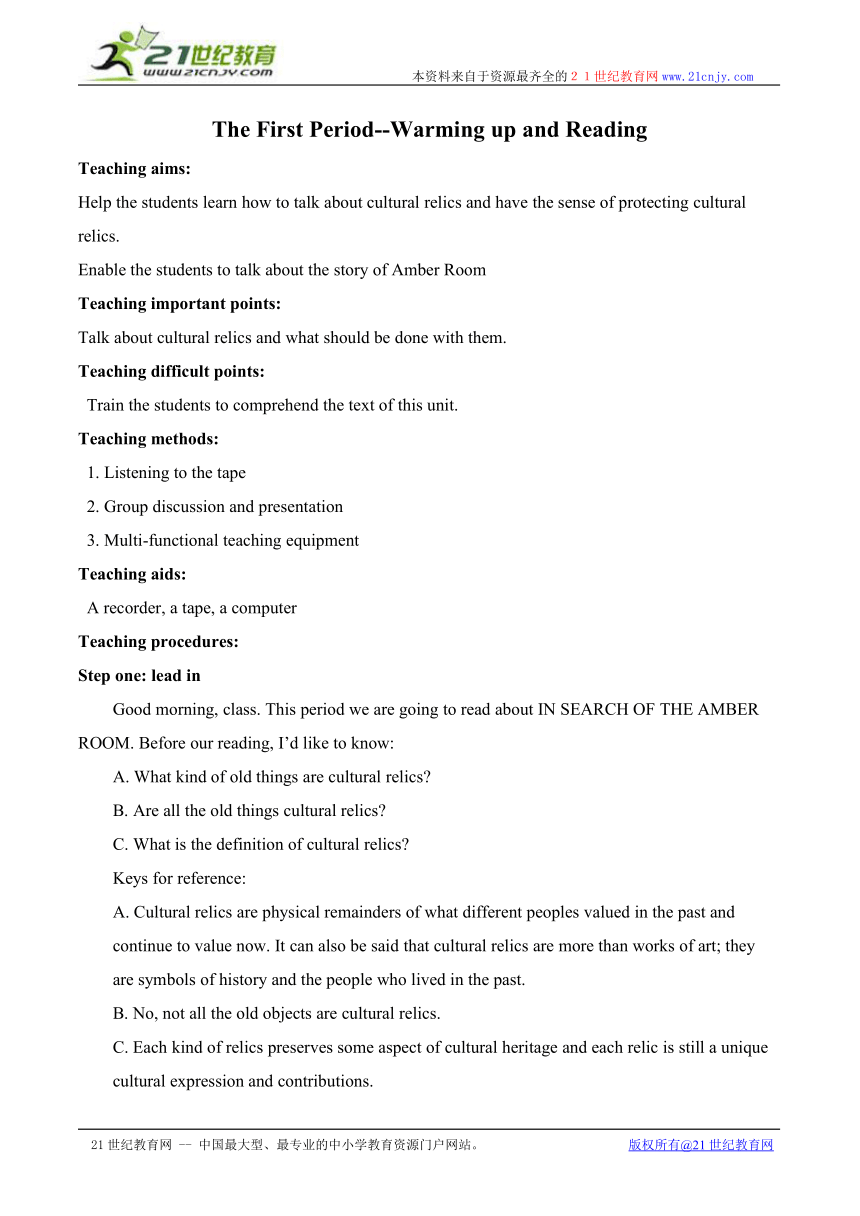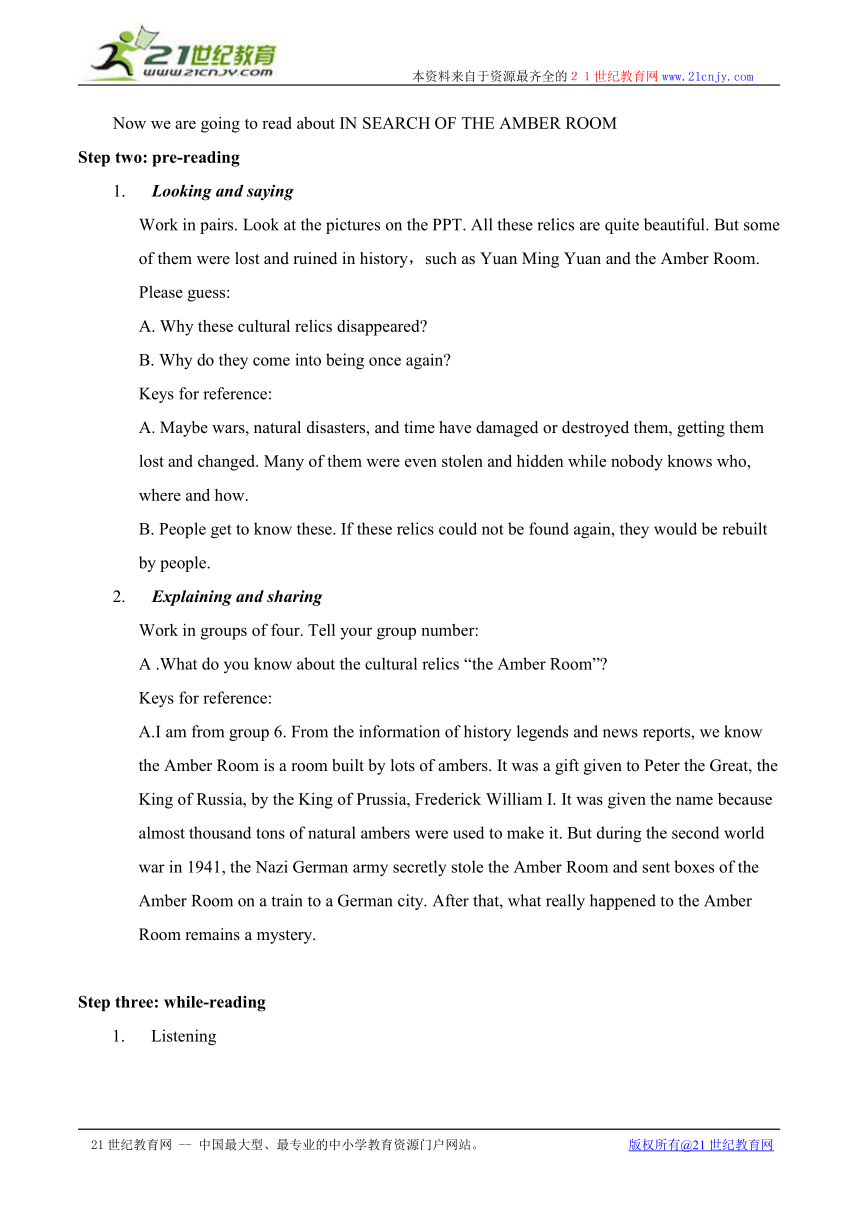Unit 1 Cultural relics The First Period--Warming up and Reading
文档属性
| 名称 | Unit 1 Cultural relics The First Period--Warming up and Reading |  | |
| 格式 | rar | ||
| 文件大小 | 14.2KB | ||
| 资源类型 | 教案 | ||
| 版本资源 | 人教版(新课程标准) | ||
| 科目 | 英语 | ||
| 更新时间 | 2008-11-13 12:47:00 | ||
图片预览


文档简介
本资料来自于资源最齐全的21世纪教育网www.21cnjy.com
The First Period--Warming up and Reading
Teaching aims:
Help the students learn how to talk about cultural relics and have the sense of protecting cultural relics.
Enable the students to talk about the story of Amber Room
Teaching important points:
Talk about cultural relics and what should be done with them.
Teaching difficult points:
Train the students to comprehend the text of this unit.
Teaching methods:
1. Listening to the tape
2. Group discussion and presentation
3. Multi-functional teaching equipment
Teaching aids:
A recorder, a tape, a computer
Teaching procedures:
Step one: lead in
Good morning, class. This period we are going to read about IN SEARCH OF THE AMBER ROOM. Before our reading, I’d like to know:
A. What kind of old things are cultural relics
B. Are all the old things cultural relics
C. What is the definition of cultural relics
Keys for reference:
A. Cultural relics are physical remainders of what different peoples valued in the past and continue to value now. It can also be said that cultural relics are more than works of art; they are symbols of history and the people who lived in the past.
B. No, not all the old objects are cultural relics.
C. Each kind of relics preserves some aspect of cultural heritage and each relic is still a unique cultural expression and contributions.
Now we are going to read about IN SEARCH OF THE AMBER ROOM
Step two: pre-reading
1. Looking and saying
Work in pairs. Look at the pictures on the PPT. All these relics are quite beautiful. But some of them were lost and ruined in history,such as Yuan Ming Yuan and the Amber Room. Please guess:
A. Why these cultural relics disappeared
B. Why do they come into being once again
Keys for reference:
A. Maybe wars, natural disasters, and time have damaged or destroyed them, getting them lost and changed. Many of them were even stolen and hidden while nobody knows who, where and how.
B. People get to know these. If these relics could not be found again, they would be rebuilt by people.
2. Explaining and sharing
Work in groups of four. Tell your group number:
A .What do you know about the cultural relics “the Amber Room”
Keys for reference:
A.I am from group 6. From the information of history legends and news reports, we know the Amber Room is a room built by lots of ambers. It was a gift given to Peter the Great, the King of Russia, by the King of Prussia, Frederick William I. It was given the name because almost thousand tons of natural ambers were used to make it. But during the second world war in 1941, the Nazi German army secretly stole the Amber Room and sent boxes of the Amber Room on a train to a German city. After that, what really happened to the Amber Room remains a mystery.
Step three: while-reading
1. Listening
Listen to the record of the text IN SEARCH OF THE AMBER ROOM. Pay attention to the pronunciation of each word and the pauses within each sentence. And answer the following questions:
1) Why was it called Amber Room
2) How many tons of amber were used to make the Amber Room
3) What else were used to make the room besides amber
4) When and why did Frederick William I give the Amber Room to Peter the Great
5) What did Peter the Great give in return
6) What did Catherine the Great do with the Amber Room?
7) When and how was the Amber Room supposed to have been lost
2. Skimming and identifying the general idea of each paragraph Now please skim the text to get the key words and general idea of each paragraph
1st paragraph the introduction about the Amber Room: design, colour, shape, material
2nd paragraph the present to the Czar: a part of winter palace in St. Petersburg, a reception hall for important visitor
3rd Paragraph the relocating of the Amber Room in Catherine Ⅱ times: moved into Summer Palace, more added to its design
4th Paragraph the missing of the Amber Room: the two countries were at war, Nazi German army stole the Amber Room, 27 wooden boxes were trained to a German city, Nobody knew it from then on
5th Paragraph the rebuilding of the Amber Room: a new one but the same as the old built by the two countries, for celebrating the 300th birthday of Petersburg
Step four: post-reading
1. Read the text again quickly and finish the comprehending exercise. Explain why you choose that answer.
Step five: summary
1. learn something about cultural relics
2. main idea of the text
Step six: homework
1. Underline all the useful expressions in the passage. Copy them to your notebook after class as homework.
2. Surf on the website after class: Names of people and Names of places
Frederick Ⅰ Prussia
Frederick William Ⅰ St. Petersburg
Peter the Great the Baltic Sea
Catherine Ⅱ Winter Palace
Step seven: feedback
Step eight: blackboard design
Step nine: reference materials
21世纪教育网 -- 中国最大型、最专业的中小学教育资源门户网站。 版权所有@21世纪教育网
The First Period--Warming up and Reading
Teaching aims:
Help the students learn how to talk about cultural relics and have the sense of protecting cultural relics.
Enable the students to talk about the story of Amber Room
Teaching important points:
Talk about cultural relics and what should be done with them.
Teaching difficult points:
Train the students to comprehend the text of this unit.
Teaching methods:
1. Listening to the tape
2. Group discussion and presentation
3. Multi-functional teaching equipment
Teaching aids:
A recorder, a tape, a computer
Teaching procedures:
Step one: lead in
Good morning, class. This period we are going to read about IN SEARCH OF THE AMBER ROOM. Before our reading, I’d like to know:
A. What kind of old things are cultural relics
B. Are all the old things cultural relics
C. What is the definition of cultural relics
Keys for reference:
A. Cultural relics are physical remainders of what different peoples valued in the past and continue to value now. It can also be said that cultural relics are more than works of art; they are symbols of history and the people who lived in the past.
B. No, not all the old objects are cultural relics.
C. Each kind of relics preserves some aspect of cultural heritage and each relic is still a unique cultural expression and contributions.
Now we are going to read about IN SEARCH OF THE AMBER ROOM
Step two: pre-reading
1. Looking and saying
Work in pairs. Look at the pictures on the PPT. All these relics are quite beautiful. But some of them were lost and ruined in history,such as Yuan Ming Yuan and the Amber Room. Please guess:
A. Why these cultural relics disappeared
B. Why do they come into being once again
Keys for reference:
A. Maybe wars, natural disasters, and time have damaged or destroyed them, getting them lost and changed. Many of them were even stolen and hidden while nobody knows who, where and how.
B. People get to know these. If these relics could not be found again, they would be rebuilt by people.
2. Explaining and sharing
Work in groups of four. Tell your group number:
A .What do you know about the cultural relics “the Amber Room”
Keys for reference:
A.I am from group 6. From the information of history legends and news reports, we know the Amber Room is a room built by lots of ambers. It was a gift given to Peter the Great, the King of Russia, by the King of Prussia, Frederick William I. It was given the name because almost thousand tons of natural ambers were used to make it. But during the second world war in 1941, the Nazi German army secretly stole the Amber Room and sent boxes of the Amber Room on a train to a German city. After that, what really happened to the Amber Room remains a mystery.
Step three: while-reading
1. Listening
Listen to the record of the text IN SEARCH OF THE AMBER ROOM. Pay attention to the pronunciation of each word and the pauses within each sentence. And answer the following questions:
1) Why was it called Amber Room
2) How many tons of amber were used to make the Amber Room
3) What else were used to make the room besides amber
4) When and why did Frederick William I give the Amber Room to Peter the Great
5) What did Peter the Great give in return
6) What did Catherine the Great do with the Amber Room?
7) When and how was the Amber Room supposed to have been lost
2. Skimming and identifying the general idea of each paragraph Now please skim the text to get the key words and general idea of each paragraph
1st paragraph the introduction about the Amber Room: design, colour, shape, material
2nd paragraph the present to the Czar: a part of winter palace in St. Petersburg, a reception hall for important visitor
3rd Paragraph the relocating of the Amber Room in Catherine Ⅱ times: moved into Summer Palace, more added to its design
4th Paragraph the missing of the Amber Room: the two countries were at war, Nazi German army stole the Amber Room, 27 wooden boxes were trained to a German city, Nobody knew it from then on
5th Paragraph the rebuilding of the Amber Room: a new one but the same as the old built by the two countries, for celebrating the 300th birthday of Petersburg
Step four: post-reading
1. Read the text again quickly and finish the comprehending exercise. Explain why you choose that answer.
Step five: summary
1. learn something about cultural relics
2. main idea of the text
Step six: homework
1. Underline all the useful expressions in the passage. Copy them to your notebook after class as homework.
2. Surf on the website after class: Names of people and Names of places
Frederick Ⅰ Prussia
Frederick William Ⅰ St. Petersburg
Peter the Great the Baltic Sea
Catherine Ⅱ Winter Palace
Step seven: feedback
Step eight: blackboard design
Step nine: reference materials
21世纪教育网 -- 中国最大型、最专业的中小学教育资源门户网站。 版权所有@21世纪教育网
